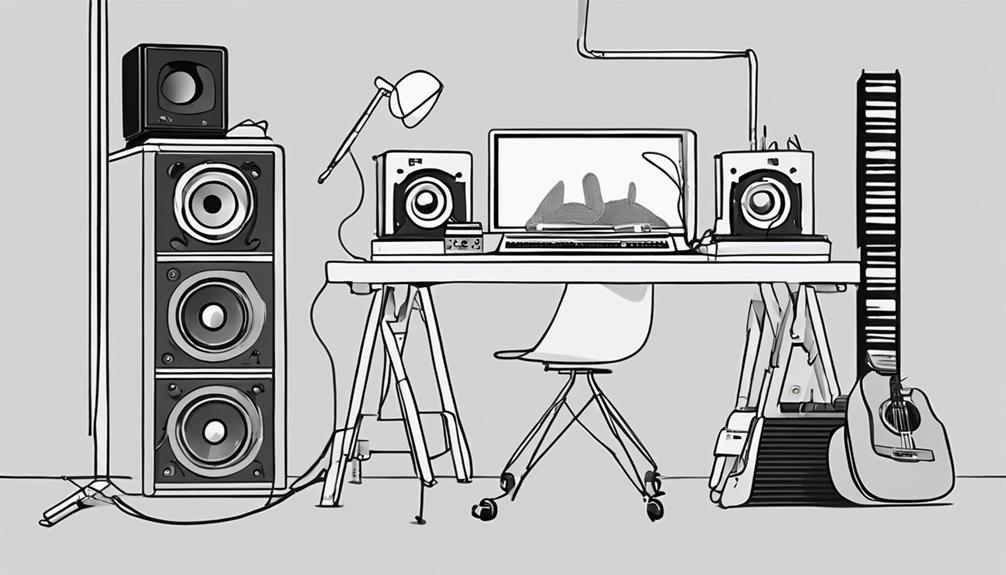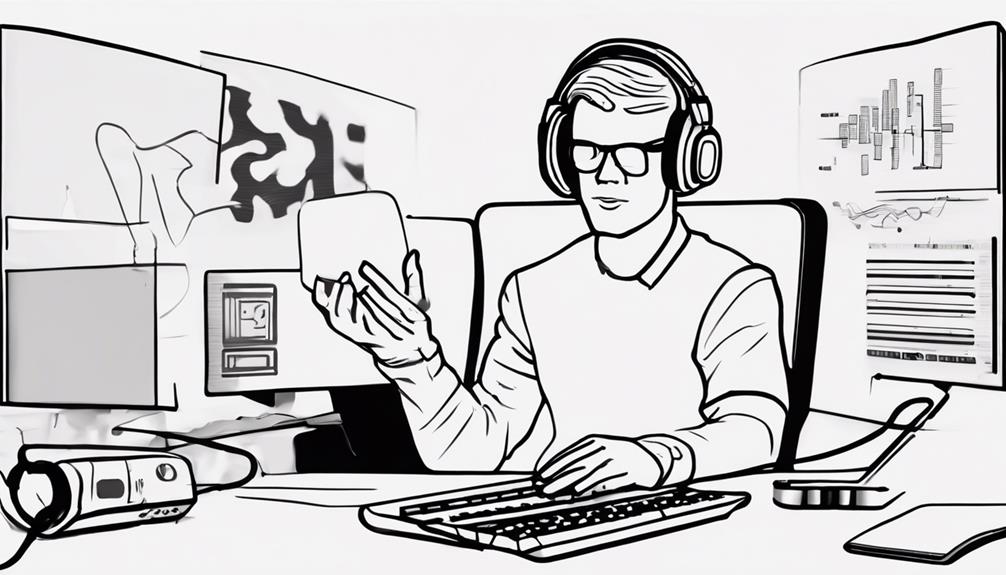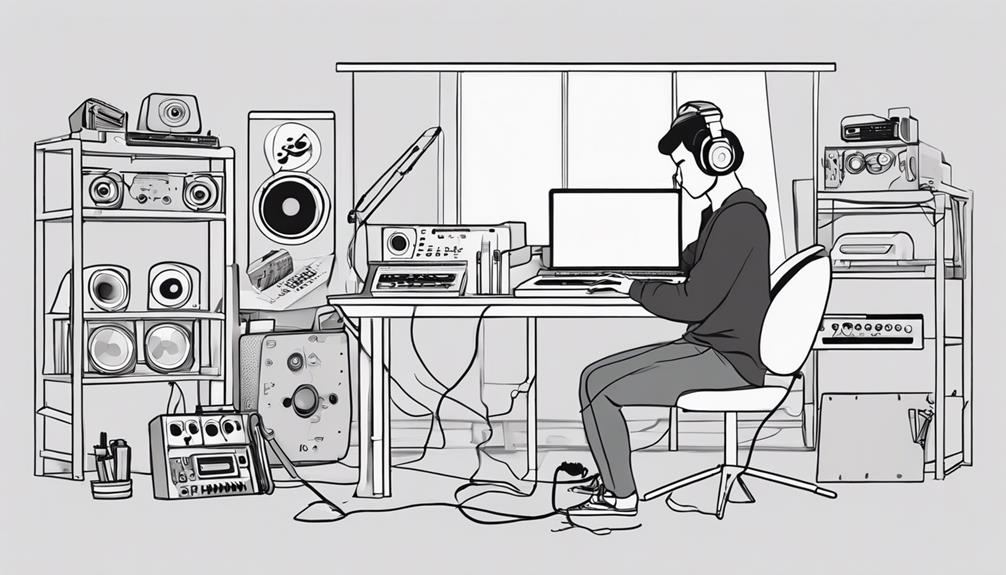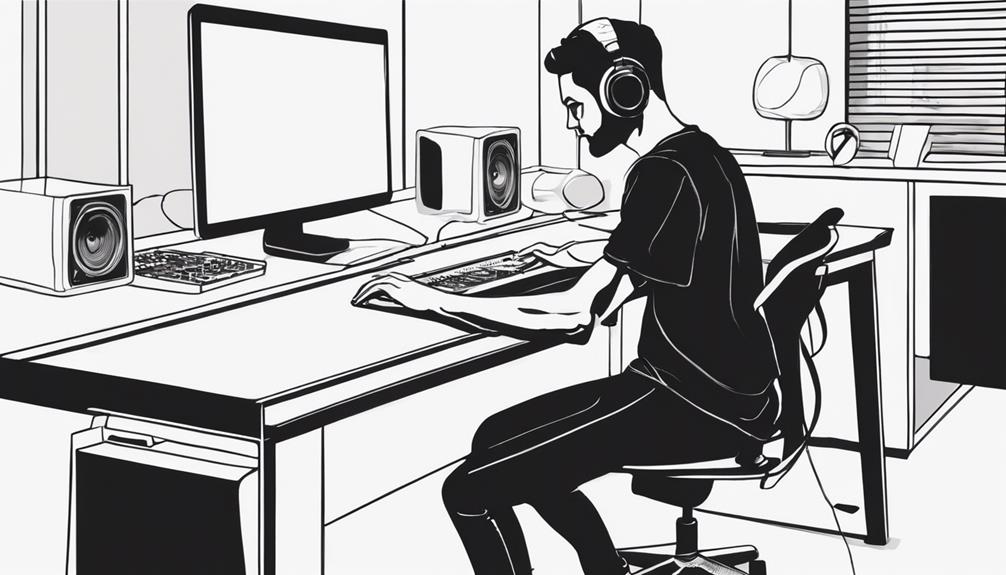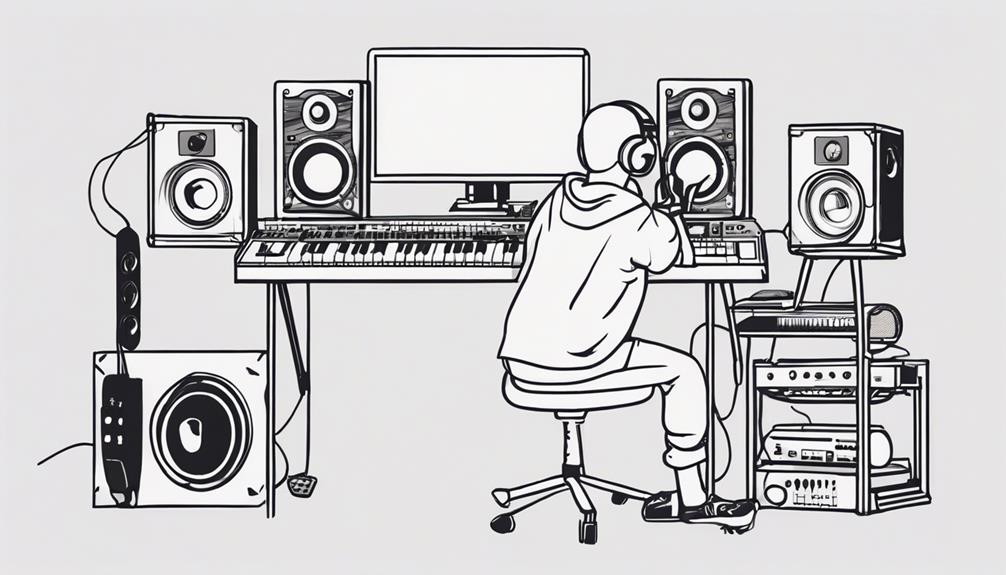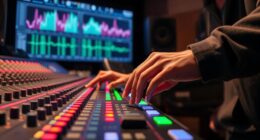Ready to start music production at home? Begin by gathering essential gear like a computer, DAW, and studio monitors. Set up your studio, focusing on room treatment and monitor placement. Develop your sound by experimenting with recording techniques and effects. Build your studio with equipment like studio headphones and MIDI keyboards. Quality headphones are essential for accurate monitoring. Record in a dedicated space with quality equipment. Learn mixing and mastering basics for a polished final product. Release your music independently to maintain creative control. Explore tips and resources to enhance your skills further. Ready to kickstart your journey? Take advantage of the endless tutorials and guides available online to sharpen your skills and stay inspired. If you’re looking to start music production on Ableton, explore its powerful features like session view and audio effects to bring your ideas to life. Remember, consistency and creativity are key—keep experimenting and refining your craft every step of the way.
Key Takeaways
- Set up a dedicated workspace with proper acoustics and minimal distractions.
- Invest in essential gear like a computer, DAW software, studio monitors, and microphones.
- Utilize online resources, tutorials, and courses to enhance music production skills.
- Experiment with different production styles and genres to develop a unique sound.
- Collaborate virtually with other musicians and artists for inspiration and insights.
Essential Gear for Home Production
To set up a successful home music production environment, you need essential gear like a computer, Digital Audio Workstation (DAW), audio interface, studio monitors, and microphones.
When it comes to music production in your home recording studio, having the right tools is vital. Audio interfaces act as the bridge between your instruments, microphones, and computer, ensuring seamless connectivity for your projects.
Studio monitors are essential for accurate sound reproduction, allowing you to mix and master your tracks effectively.
Different types of microphones play a significant role in capturing various sounds during recording sessions. Condenser microphones are ideal for capturing vocals and acoustic instruments with clarity, while dynamic mics excel in handling high sound pressure levels like drums and guitar amps.
Additionally, incorporating a MIDI keyboard into your setup can enhance your production capabilities by enabling easy input of melodies and chords.
Setting Up Your Home Studio
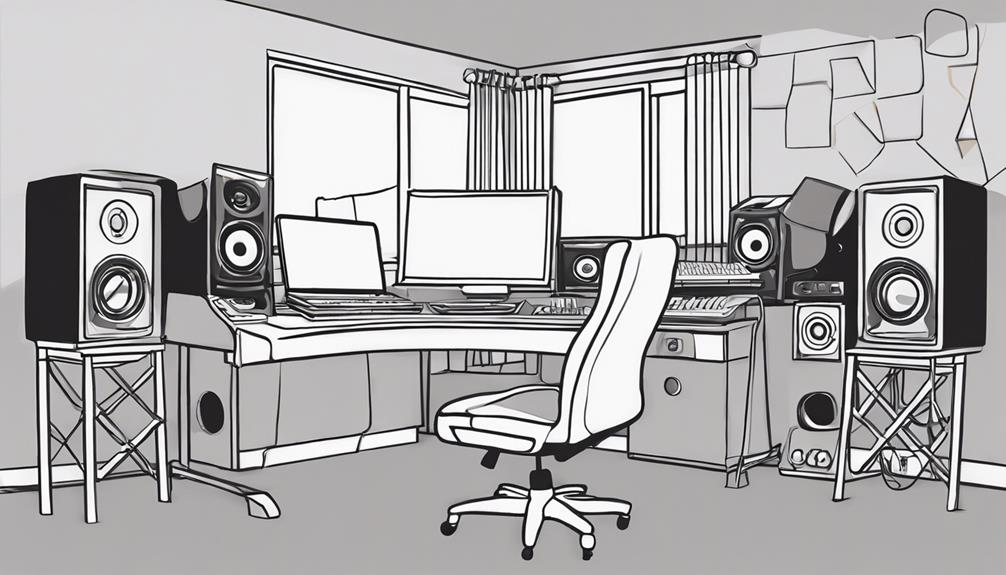
When setting up your home studio, make sure you select a dedicated space that offers good acoustics and minimal noise. This is important for ensuring the quality of sound in your recordings and mixes.
To create an ideal home studio setup, consider the following:
- Choose the Right Audio Interface: Select an audio interface that aligns with your recording needs and provides high-quality sound input and output. This is essential for capturing and reproducing your music accurately.
- Invest in Room Treatment: Enhance the acoustics of your space by incorporating room treatment options such as acoustic panels and bass traps. These additions can greatly improve the sound quality in your studio by reducing unwanted reflections and echoes.
- Select Quality Studio Monitors: Opt for studio monitors that offer precise sound reproduction. Quality studio monitors are crucial for making informed mixing decisions and ensuring that your music translates well across different playback systems.
Online Music Production Courses

Consider enrolling in online music production courses to expand your skills and knowledge conveniently from home. These courses provide flexibility in learning, allowing you to explore various aspects of music production such as music theory, sound design, mixing, and mastering.
Platforms like Coursera, Udemy, and Skillshare offer a plethora of courses taught by industry professionals. You can access course materials, tutorials, and assignments at your own pace, making it easier to balance learning with other commitments.
Whether you're a beginner looking to understand the basics or an intermediate/advanced learner seeking to refine your skills, online music production courses cater to a wide range of proficiency levels. By taking advantage of these courses, you can enhance your understanding of music production techniques and concepts without having to leave the comfort of your home.
Developing Your Signature Sound
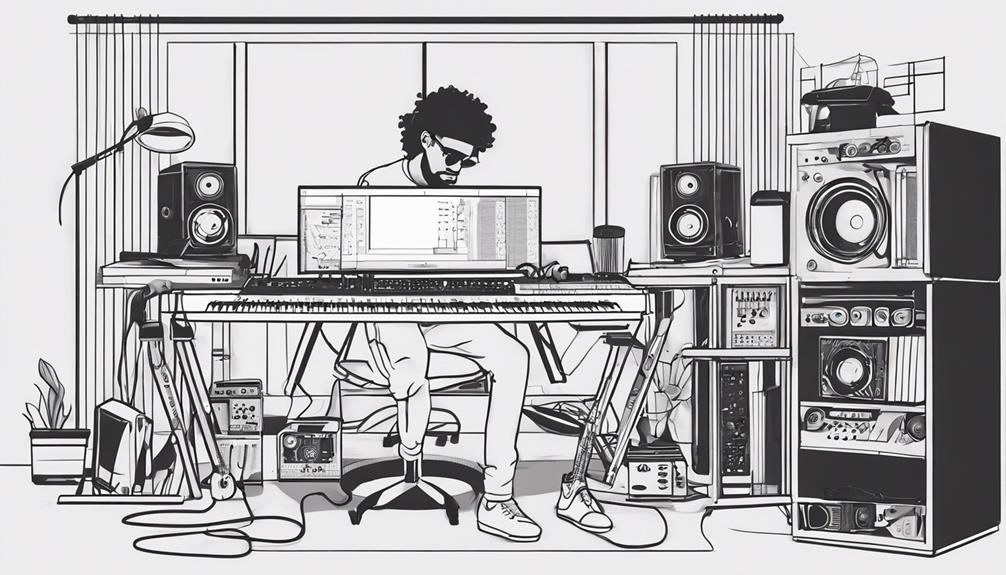
To create a unique sound, experiment with various recording techniques, effects, and instruments.
Incorporate unconventional elements like vocal effects or personalized mixing styles to set your music apart.
Learn from your favorite producers and artists to inspire and shape your own signature sound.
Sound Experimentation Techniques
Experiment with a variety of effects, plugins, and processing techniques to craft a unique sonic identity that sets your music apart.
When delving into sound experimentation, consider the following:
- Incorporate Unconventional Instruments: Integrate unique sounds from unconventional instruments, field recordings, or found objects to add a distinctive touch to your tracks.
- Explore Different Tempos and Time Signatures: Break away from standard rhythms by experimenting with diverse tempos and time signatures, creating a fresh and engaging listening experience.
- Utilize Creative Sampling Techniques: Embrace innovative sampling methods like granular synthesis or spectral processing to manipulate sounds in ways that add depth and originality to your music.
Instrument Selection Tips
When developing your signature sound, explore a variety of musical instruments to discover the ones that best resonate with your unique style and musical vision.
Consider incorporating a mix of traditional and electronic instruments to create a distinctive blend in your music production. Think about the timbre, range, and versatility of different instruments as you shape your signature sound.
Experiment with various playing techniques and effects to add depth and character to your instrumentals, helping you stand out in the music scene.
It's vital to focus on mastering a few key instruments rather than spreading yourself too thin across different options. By honing your skills on select instruments, you can develop a cohesive and recognizable sound that defines your music productions.
Mixing and Mastering Essentials
Explore various techniques in mixing and mastering to shape a distinctive sonic identity for your music productions.
When working on mixing, focus on balancing and blending audio tracks, adjusting volume levels, panning instruments in the stereo field, and shaping the overall tone of the music.
In mastering, concentrate on enhancing the overall sound quality, ensuring consistency across tracks, and preparing the music for distribution.
To develop a signature sound, experiment with different techniques, effects, and processing tools like parallel processing, EQ adjustments, compression, reverb, and automation. These elements play important roles in shaping the final mix and master of a track.
Remember, a well-crafted mix and master can elevate the overall impact of a song, making it sound professional, cohesive, and ready for various listening environments.
Embrace these essential steps to create music that truly reflects your unique style and vision.
Building Your Home Studio Setup
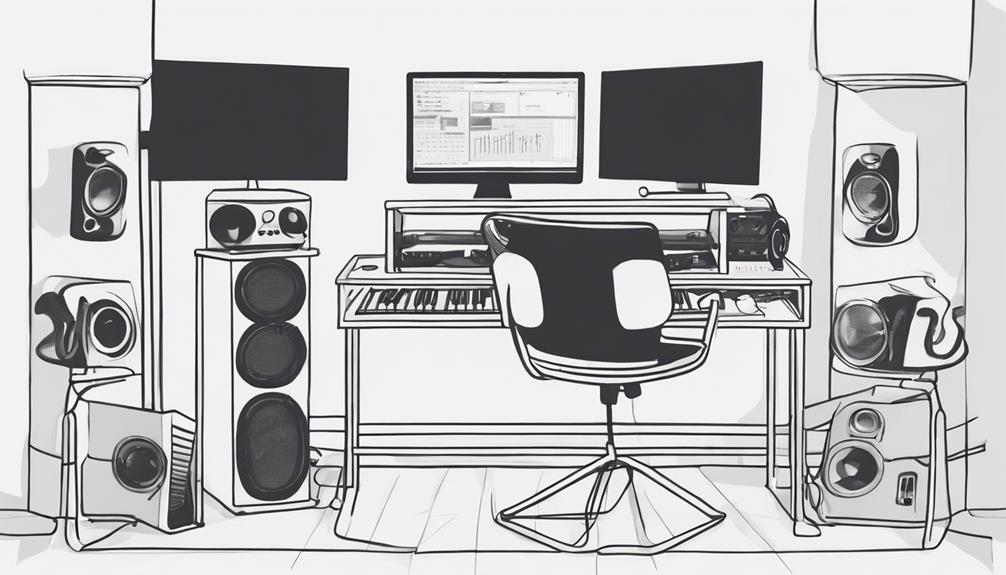
Get ready to set up your home studio for music production! Equip yourself with essential gear and focus on setting up the acoustics just right.
These steps will lay the foundation for creating professional-sounding music right from the comfort of your home.
Essential Equipment for Setup
To build your home studio setup effectively, start by gathering essential equipment such as a computer, Digital Audio Workstation (DAW), studio monitors, audio interface, and microphones. These tools are vital for recording, producing, and mixing music at home.
Additionally, consider investing in the following:
- Studio Headphones: Necessary for accurate monitoring and sound evaluation during music production.
- MIDI Keyboard: Provides tactile control over virtual instruments, enhancing the creative process in your home studio.
- Amplifiers: Essential for driving studio monitors and headphones, ensuring you hear your music at the right volume and clarity.
Remember that selecting high-quality gear tailored to your budget and production needs is key to achieving professional results in your home studio. By focusing on these essentials, you can create a productive and inspiring environment for your music production endeavors.
Setting up Acoustics
When setting up your home studio for music production, focusing on acoustics is essential for achieving professional sound quality. Consider your room size, shape, and materials to optimize acoustics in your space.
Utilize acoustic panels, bass traps, and diffusers to control sound reflections and frequencies, ensuring a balanced sound. Properly position your studio monitors to minimize unwanted reverberations and improve sound quality. Additionally, investing in quality headphones is important for accurate audio monitoring.
Experiment with room layout and furniture placement to further enhance the acoustics of your studio.
Acoustic panels, bass traps, and diffusers help manage sound reflections and frequencies, creating a more controlled environment for mixing and recording. Studio monitors play an important role in accurately reproducing sound, so make sure they're correctly placed for best performance.
Quality headphones are crucial for monitoring audio details and ensuring that your mixes translate well across different playback systems. By adjusting your room layout and furniture placement, you can further refine the acoustics of your home studio setup.
Recording Music at Home
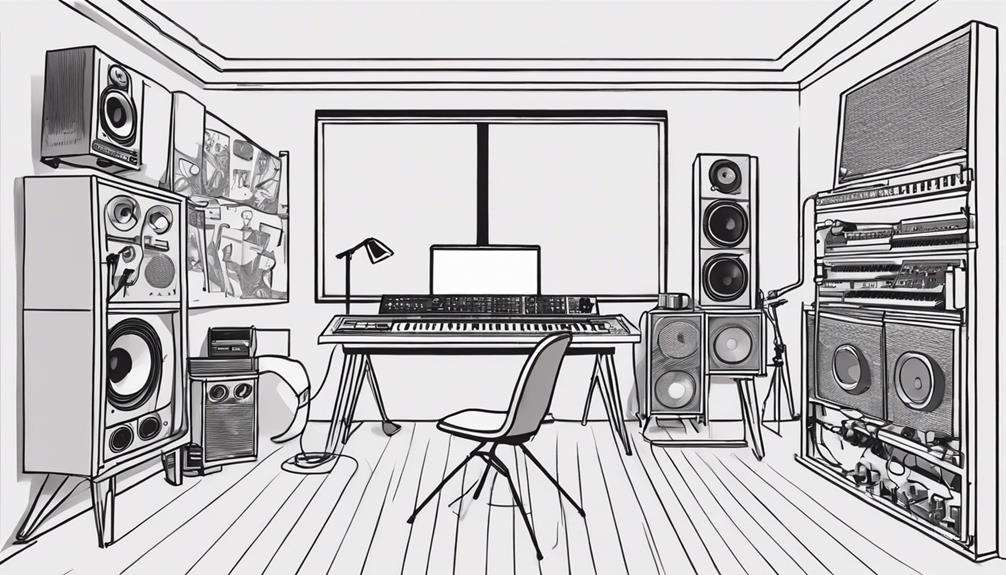
Establishing a dedicated recording space with proper acoustics and minimal background noise is essential when starting to record music at home.
To get started on recording music at home effectively, consider the following tips:
- Invest in Quality Equipment: Acquire a computer, Digital Audio Workstation (DAW), a quality microphone, and an audio interface to guarantee professional-grade recordings.
- Utilize Virtual Instruments: Experiment with virtual instruments and plugins within your DAW to access a diverse range of sounds and effects for your recordings.
- Experiment with Techniques: Try out different microphone placements and recording techniques to capture the best sound for vocals, acoustic instruments, and other audio sources.
Mixing and Mastering Basics
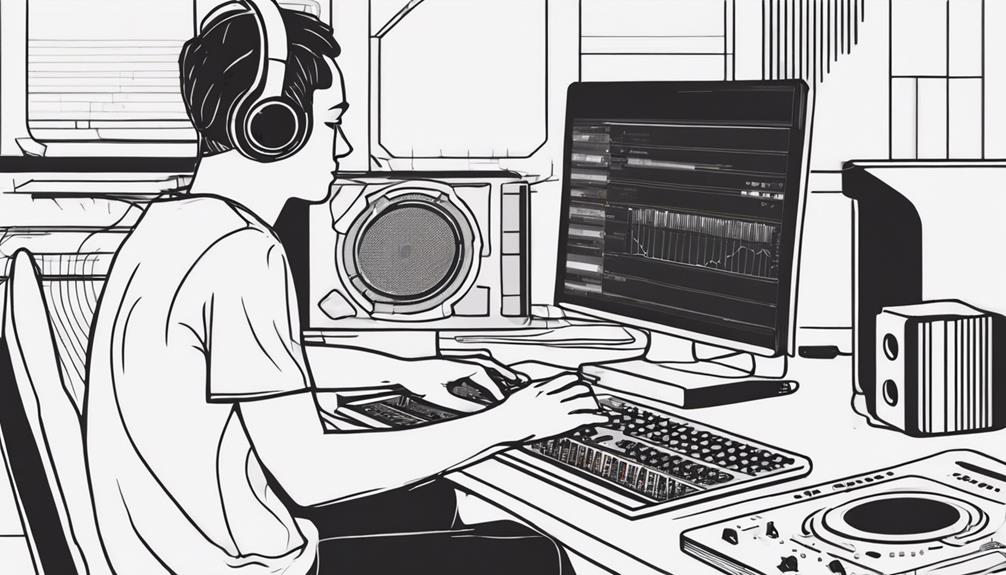
When considering the final touches to your home-recorded music, understanding the basics of mixing and mastering is key to achieving a professional sound. Mixing involves balancing tracks, blending them together to create a cohesive sound. This process includes adjusting levels, panning, EQ settings, and adding effects like reverb and delay to polish the sound.
On the other hand, mastering is the final step that focuses on enhancing the overall volume, EQ, dynamics, and ensuring consistency across all tracks in an album. To achieve high-quality results in mixing and mastering, professionals use specialized software and hardware tools. These tools help in fine-tuning every aspect of the audio to deliver a polished and cohesive final product ready for distribution.
Releasing Your Music Independently

To release your music independently, you can take advantage of various online platforms that offer easy distribution and allow you to maintain creative control over your work. By opting for DIY music releases, you empower yourself to shape your artistic vision and connect directly with your audience. Here are some key benefits of independently releasing music:
- Maintaining Creative Control: With independent releases, you have the freedom to make artistic decisions without external influences.
- Utilizing Distribution Platforms: Platforms like Bandcamp, Spotify, and SoundCloud enable you to share your music globally and reach a broader audience.
- Building Your Brand: Independent releases give you the opportunity to build a unique brand identity, engage with fans authentically, and potentially generate revenue through your music.
Embracing independent music production not only allows you to share your creations with the world but also empowers you to cultivate a loyal fan base on your terms.
Tips for Home Music Production
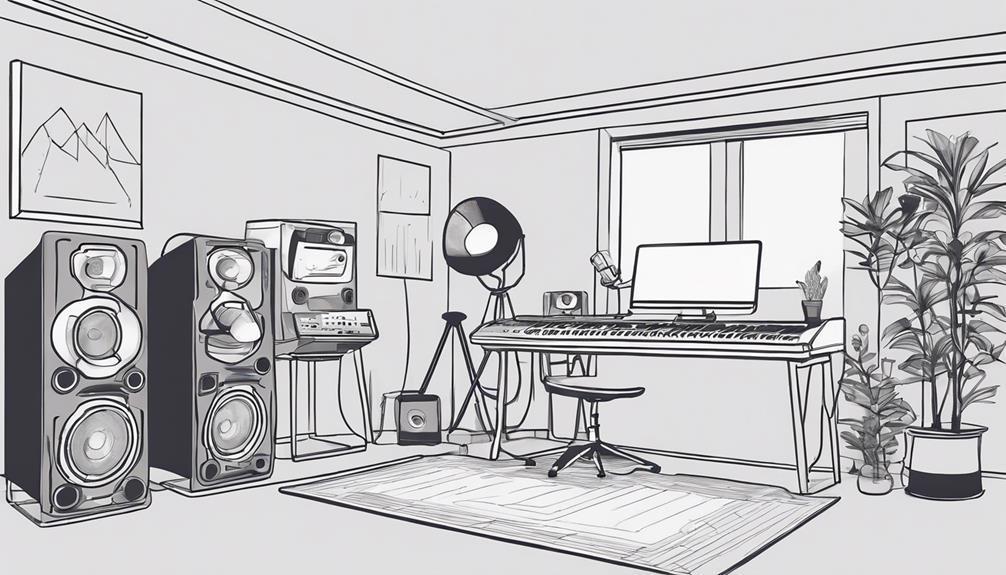
Creating a dedicated workspace with proper acoustics and minimal distractions is crucial for optimizing your music production setup at home. Make sure your space is conducive to creativity and focus by setting up your essential gear, including a computer, DAW software, audio interface, studio monitors, and microphones.
Explore online resources, tutorials, and courses to elevate your skills and explore new techniques within the comfort of your home studio. Experiment with various production styles and genres to develop a unique sound that represents your artistic vision.
Don't hesitate to collaborate virtually with other musicians, producers, and artists to exchange insights, feedback, and inspiration for your home music production projects. By incorporating these tips into your DIY Guide for home music production, you can refine your craft and engage in your creativity in the most effective and enjoyable way possible.
Frequently Asked Questions
How to Produce Music at Home for Beginners?
You can produce music at home as a beginner by starting with basic gear like a computer, DAW, and headphones. Learn software basics, master recording, mixing, and mastering techniques. Explore online tutorials for guidance. Experiment to find your unique style.
Can I Self Teach Myself Music Production?
You can definitely self-teach music production! Just like you, many beginners have successfully learned by watching online tutorials. With dedication and practice, you'll be able to hone your skills and create incredible music from home.
What Do I Need to Start Producing House Music?
You need a computer with music production software, a MIDI controller for hands-on control, quality studio headphones, studio monitors for precise listening, and virtual instruments/sample libraries to start producing house music at home.
How Do I Start Myself as a Music Producer?
Ready to embark on your journey as a music producer? Immerse yourself in online tutorials, experiment with your gear, and practice recording and mixing tracks. Collaborate with others, stay updated on industry trends, and watch your skills soar!
Conclusion
Now that you have all the gear and knowledge you need to start music production at home, it's time to let your creativity soar. Picture yourself in your cozy home studio, surrounded by your favorite instruments and equipment, crafting the perfect track that captures your unique sound.
With dedication and practice, you'll be releasing your music independently in no time. Keep pushing boundaries and exploring new sounds – the possibilities are endless!

